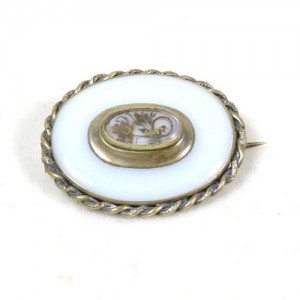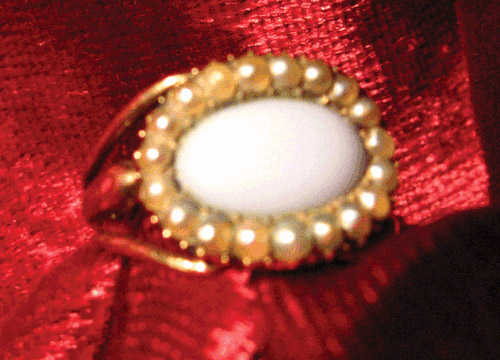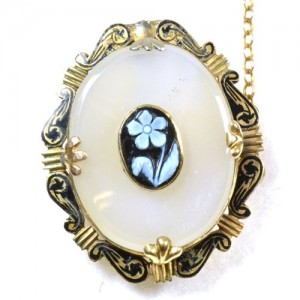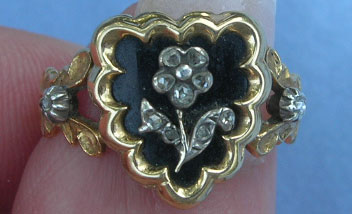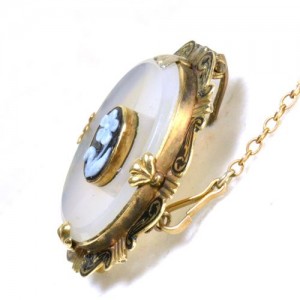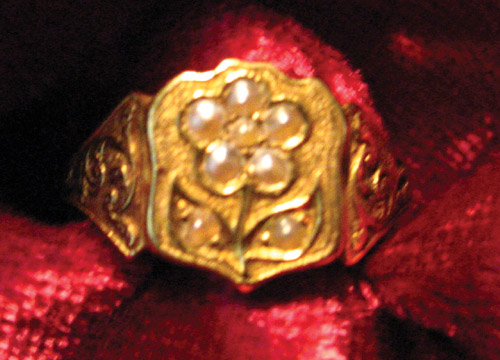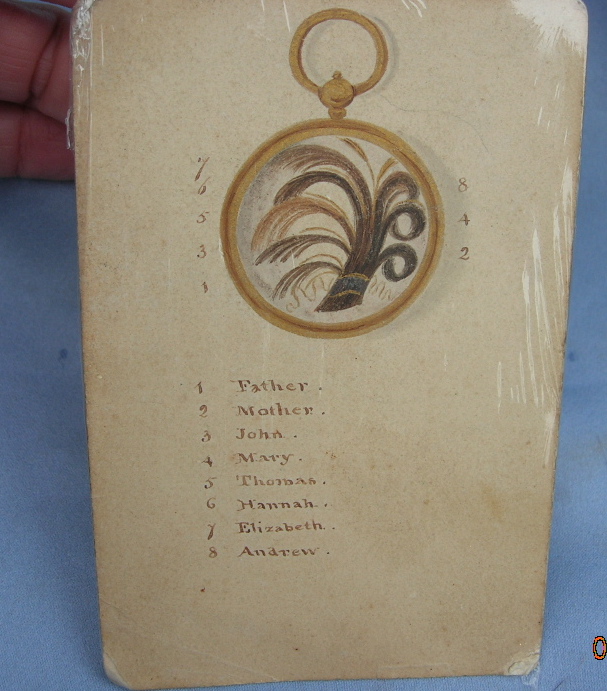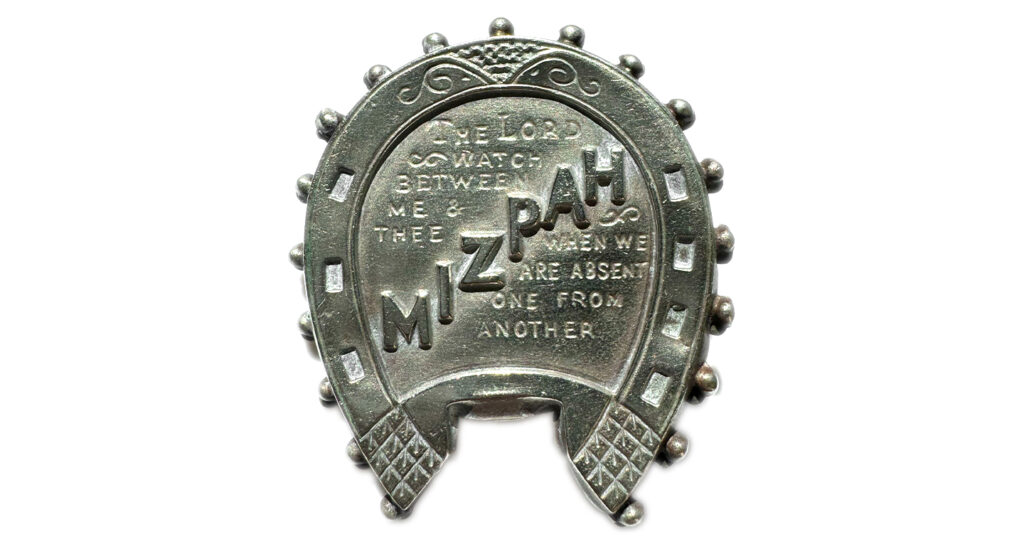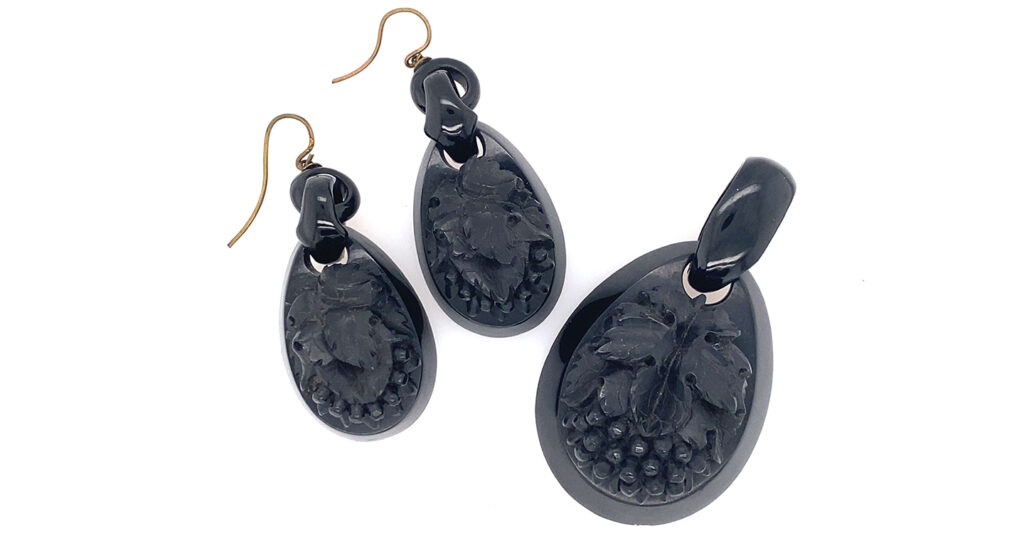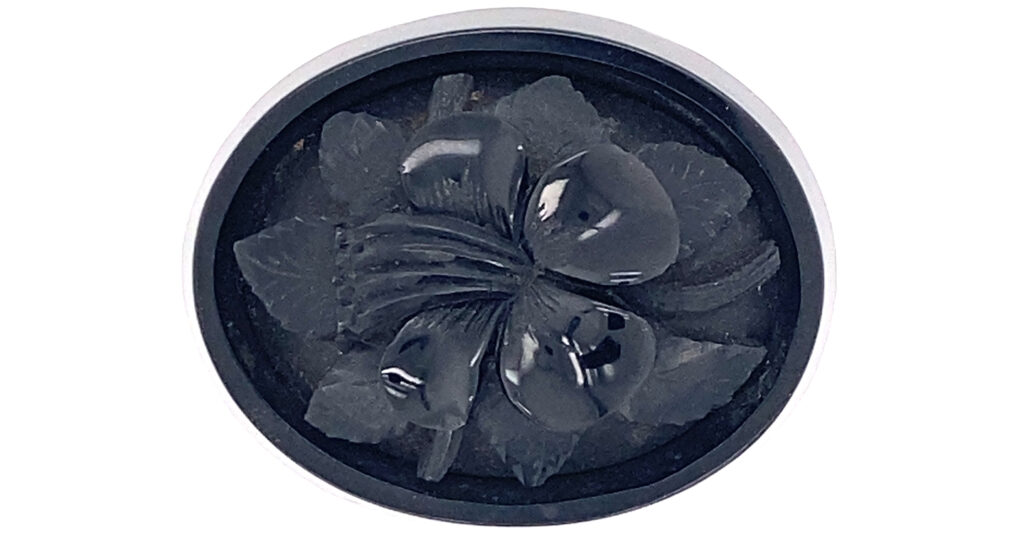A Mourning Tour: Chalcedony and Sentimental Brooches in the 19th Century
The 19th century saw a massive swing towards sentimental jewellery, with an industry that could sustain itself through being popular in mainstream fashion. Today, let’s look to two brooches of similar age and notice their use of common themes and also how they developed to that point in time. Sentimental jewels were in many ways a necessity as much as a privilege for their times; defining the love of a person who wore/gave them and displaying that to the public. These brooches show hair, chalcedony, enamel and the forget-me-not motif in a way that sets them apart differently, but keeps them firmly related through many similar elements. Let’s take a closer look at the times and move into their finer details.
The Mid 19th Century and Jewellery
Innovation led by Albert, Prince Consort cannot be understated for its values and impact upon society. The Great Exhibition of 1851 came about during a time of European and Latin American economic turmoil in 1848, leading to revolutions following the rise of nationalism. Albert’s dedication towards acknowledging the underprivileged and offering financial and educational assistance was an incredibly bold stance for the time, particularly when his family in Europe was being threatened. Since 1843, Albert was President of the Society of Arts, which, from its annual exhibition, became the basis for the Great Exhibition. Based in Hyde Park within The Crystal Palace, the value of science, art and industry became a matter of pride for British society, which is a progressive step and one that shows the great innovation of Albert, himself. As a counter to revolution, The Great Exhibition stood fast and as a catalyst for art and innovation, the impact upon jewellery design that was revealed through new techniques of metallurgy and style resonated back through society.
The 1850s led much of this standardisation, with the family elements that were instilled by Victoria and Albert becoming popular in terms of literature and fashion. New challenges, such as Darwin’s The Origin of the Species, threatened the Christian family that had been established by Victoria and Albert, but fashion was still permeable. Romanticism flourished in literature and art, notably by the Pre-Raphaelite Brotherhood in the late 1840s. Looking towards medieval culture for inspiration and harshly turning against realism, many of the mourning and sentimental symbols that are common today in jewellery and funerary art were carried through by their use in art. Within literature, one must not look past Charles Dickens for the usage of Victorian sensibilities and values within his writing.
Albert died in 1861, effectively locking Victoria in a period of perpetual mourning. The effect of this was felt within jewellery design, leading to a very static period for jewellery design in the remaining century.
Bolder style was in its element during the 1860s. This can be attributed to the mourning of Queen Victoria from 1861, but also tells of the evolution in costume and everyday dress.
The larger styles of the mid-Victorian era had taken hold, with female fashion becoming larger and the jewels needed to adapt.
By the latter century, costume and function were tightly connected for women. Dresses of separate bodice and skirt were worn in bombazine covered in crape. Underwear was often white chemises, drawers and under petticoats slotted with black ribbon. Black caps, crape trimmed bonnets, and long veils.
First mourning lasted one year and a day, outdoor garments for this would be shown by the plainness and amount of crape, jet jewellery was permitted. After one year and a day, Second stage was introduced. This involved less crape and its application to bonnets and dresses became more elaborate. It was frowned upon if this period was entered into too quickly and it lasted nine months in all. The Third stage (or Ordinary stage), introduced after twenty-one months, involves the omission of crape, inclusion of black silk trimmed with jet, black ribbon and embroidery or lace were permitted.
Post 1860, soft mauves, violet, pansy, lilac, scabious and heliotrope were acceptable in half mourning. This period lasted three months. The English Woman’s Domestic Magazine stated that ‘many widows never put on their colours again’ and this was quite a statement for the identity of the woman, which was held under the veil of mourning and family symbolism for the rest of her life. Hats, shawls, mantles, gloves, shoes, fans all changed during mid century, and pagoda sleeves from 1850-70 were fashionable, designed to be stitched to the outer sleeve to cover modesty from the lower arm and wrist. Wide skirts from the 1850s-70s, tie back fashions of the late 1870s and the ‘S-bend’ look of the early 1900s all were adapted to mourning fashion, without a clear definition of difference between them. Throughout the post 1880s decline, in the 1890s, women would wear their veils at the back of the head only, showing hair beneath bonnets at the front for first stage mourning. This defiance was quite bold and marked a large turning point for mourning structure.
Chalcedony
As these brooches show, Chalcedony had a major revival in the first quarter of the 19th century and was quite popular by the mid century in its use within sentimental brooches with the white-opaque colouring. considered its purest variety, the white and pale blue varieties are most popularly seen in jewels from the early 19th century, with a particularly good example being this ring:
Chalcedony is a term that refers to many varieties of cryptocrystalline quartz gemstones, ranging from sard, plasma, parse, bloodstone, onyx, sardonyx, carnelian, agate and many more. Early human use has been found for knives, tools, vessels and other such primitive tools. Later examples carried through history, from the creation of cylindrical seals in Mesopotamia in from the 7th century B.C.E, through to Mediterranean-based civilisations in buttons, cameos and intaglios. For these brooches, one must consider the necessity of the style in fashion and how this material could benefit its use in jewellery.
As is the case with many influential materials in jewellery construction, the access to cheaper materials often define the style which comes from it. The town of Idar-Oberstein became popular in the 19th century for its processing and carving of Chalcedony, with cheap importation of mining from Latin America. Due to its history dating back to Roman times, Idar-Oberstein provided raw agate and jasper, with a lapidary industry appearing in the 15th century to finish the materials.
Forget-me-not
Flower symbolism conveys messages that are engrained within our culture, through the last two centuries of re-enforcing their statement as symbols. The 18th and 19th centuries Romantic movement helped establish a push away from the paradigms of ecclesiastical and traditional worship, while putting the focus back upon the natural world around and the passions of the human experience. Hence it is only natural (pun intended) that as the 19th century absorbed much of the cultural shift back to traditional values during the Gothic Revival period, that many of these concepts would remain and be elaborated upon, but not revolutionised. What do I mean by this? Simply that the interpretation of flora into symbolism was aesthetically pleasing, symbolically safe (often with roots back to religious concepts) and were easy to interpret in jewellery design. The motifs worked well within the Christian concepts and symbols, so where many other symbols may cause the viewer to think twice, flora was defined and catalogued for easy interpretation and use.
“Forget-me-not, O Lord!” is what a poor German knight shouted as he fell into a river. He and his lady were picking flowers by the side of the river at the time, no doubt enjoying the beautiful day around them, and yet as fate would have it, the knight’s armour dragged him down to the bottom as he fell in. Upon his cries to the Lord, he threw the blue posy of flowers to his loved one and promptly drowned. This little tale reportedly dates to around the 15th century, but no doubt had different permeations along the way, as romantic stories often do. Hence, the concept of remembrance, eternal love and faithfulness grow from this.
Another fable is that of the baby Jesus playing magician with his mother Mary. He was quite an articulate lad and thought how wonderful it would be if everyone could see her beautiful eyes forever. He touched her eyes and waved his hands over the ground below and then the magnificent blue forget-me-nots sprung from the earth. Relating back to my earlier points of how floral symbolism was safe in the context of religion, here we have the eternal memory symbolism not only implied with its name, but infused with solid Christian concept.
Now that we have the tales out of the way, the symbolism of the forget-me-not is obviously implied within its name. It should also be noted that the flower grows quite ubiquitously in Europe, America and Asia. Its first use in English literature is reportedly from c.1532 and is otherwise named Myosotis (mouse’s ear). Interestingly enough is the rise of the flower’s popularity c.15-16th centuries. This is what we, as jewellery historians, need to understand. From this, we have the popularity of the posy ring and its use as a love token in jewellery. The posy (poesy, posie, posey) emerged at a time when modern society was developing through a shift back to the personal and emerging from the middle ages and its strict adherence to ecclesiastical living. Giving a ring with an inscription on the inside as a token of love was a profound statement, it showed that relationships were increasingly interpersonal and not decreed before god. It was between the couple. Hence, the forget-me-not was used as a decoration (often crude) in some of these rings to denote its message of love and remembrance.
During the 17th and 18th centuries, the use of the forget-me-not didn’t change, however, it did blend in well with the Rococo and Baroque excess of design well enough that it could balance with other flowers and leaf motifs. By the time of the Neoclassical period, its use was relegated more towards being a footnote in memorial jewel depictions painted on ivory. During this time and the rise of hairwork weaves becoming mainstream and popular, the forget-me-not did become a symbol used to create floral depictions from hair.
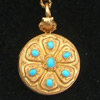
The 19th century is when the forget-me-not truly found its place as a central motif. Many rings, bracelets, brooches and mourning/sentimental peripherals showcased the forget-me-not as a primary motif, often boldly displayed on enamel. Often, other symbols (buckle/belt/serpent/cross) would complement the forget-me-not, rather than it being a symbol used as a design flourish or in repartition. Where the flower was used in more decorative areas of jewellery was in the Rococo Revival period, especially the latter 19th century, and lasted into the 20th century with its reliance on its romantic roots. Its use in the 20th century became much softer; in the Edwardian period, the romantic movement adopted the symbol and applied it (often in enamel) to lockets and by the time of the First World War, its relation to the remembrance of soldiers (carried through by poetry) and into the Second World War was assured.
Hairwork
In the first brooch of this article, there is the clear use palette-worked hair, which was designed in a way to become stylised flowers. Though the combination of hair and jewellery in design had been a popular one since the 17th century, the mid 19th century saw larger jewels appropriate more space for elaborate designs in hair. This was due to the Hallmarking Act of 1854, which allowed for lower grade alloys to be used in jewellery. With the larger styles of costume, such as the crinoline, lighter and larger jewels were welcome and could emulate gold visually.
Hairworking, as a practice, was something that could be done in the home or in a proper profession. Indeed, it was one of the earliest, early-modern, female professions within an industry, as women would be employed to weave hair. Mark Campbell’s excellent ‘The Art of Hair Work’ (1875) is a testament to how hair weaving could be accomplished as a household art and one that could also replicate the professional hair weaver. Designs and styles for woven hair could be chosen from a catalogue and the hair given to the jeweller for weaving.
By the 19th century, the custom of hairwork had become ingrained in popular culture of the time, spanning Europe to America, and the hairworking industry hit its peak. The popularity of hairwork and its move from country to country was not a singular event, but reflects more upon society of the time. Hairworking industries along the Continent have their roots in hairwork as a folk art and female amateurs practicing the art in their home. Because of this, the popularity spread through Europe, especially prominent in France, Germany, Switzerland, Sweden and even across to Bohemia.
The American hairwork industry evolved in its own right, growing in prominence over the 19th century (particularly during the Civil War) and still exists in a small capacity even today. Hairwork lends itself easily to other forms of household practices, such as stitching and weaving, which makes it transcend many cultural barriers, and the sentimentality of it only adds to its necessity. As a mourning device, hairwork is a vital memorial statement within the family. Coupled with household art in the 18th to early 20th centuries, hairwork was another way to display the loved one’s hair. Samplers and hairwork memorials are prime examples of hairwork as a folk art.
Samplers vary from country to country, as do hairwork memorials, which can take the shape of flowers within wreaths, crosses and a variety of other memorial symbols. Especially in America, hair wreaths were a “popular parlor pastime like many other crafts” for women. German and Swiss hairwork memorials were often quite different from the American, as there was a greater use of depth and colour. French were more palette-worked (cut-work and sepia) and more darker, while German and Swiss hair is fairer with greater use of watercolour. German hair memorials often used two panes of glass with one being a painted background and the foreground applied hairwork. Again, regional variation within the hairwork paradigm is the prerogative of the creator or evolution within the household.
Royalty was still the focus of the hairworking fashion for the 19th century, spanning through the Georgian and finding renewed popularity in the Victorian age. Fashion was often dictated by royalty, and it was royalty which largely perpetuated the popularity of memorial jewellery. When hairwork was worn by anyone of note, fashion often followed, as seen in the previous account of Queen Henrietta Maria and the use of memorial jewellery for Charles I during the Restoration period. In the 19th century, the executor of George IV’s estate, the Duke of Wellington, told Charles Greville that amongst George IV’s possessions he found “a prodigious quantity of hair – women’s hair – all colours and lengths, some locks with powder and pomatum still sticking to them”.
From around 1830, this quote from Wellington displays the extent to which hairwork was embraced by mainstream culture at the time. An extraordinary quantity of hair kept by George IV implies its importance as a keepsake even at the upper levels of society. Queen Victoria is one of the most popular figures regarding the rise of the mourning industry and the increasing strength of the hairworking industry. Victoria’s fastidious sentimental nature and her clinging to keepsakes can be seen in her putting Albert’s hair in brooches, bracelets and other forms of jewellery after his death. Keeping hair was as important as giving, due to the nature of the sentiment. Empress Eugenie of France was “was touched to tears when I gave her a bracelet with my hair”, wrote Queen Victoria upon presenting the bracelet 11. Though these instances of hairwork in royalty show how popular hairwork was, they are from an English perspective. Other countries and cultures developed their own hairworking industry that permeated through mainstream society of the 19th century.
In the Paris Exhibition of 1855, a life-size portrait of Queen Victoria was created, a worthwhile homage to a queen who appreciated the sentiment of hairwork so much. Indeed, with such a cultural importance on the value of hair as a material, the French were the epitome of style and to use such a material in a gesture shows just how widespread hair was used in mainstream fashion.
In 1858, fashion magazine La Belle Assemblè referred to the French hairwork artist Limmonièr in a revolutionary light. La Belle Assemblè expands on the association with hairwork as a sentimental device and identifies it as a jewellery construction material in its own right, not simply “in which some beloved tress or precious curl is entwined”.
“(Old styles) gave the appearance of having been designed from a ‘mortuary tablet’. Have we not all met ladies wearing as a brooch, by way of loving remembrance, a tomb between two willow trees formed of the hair of the individual from whom their crêpe was worn, and which from its very nature must be laid aside with it? But the new hair jewelry made by Limmonièr is an ornament for all times and places. He expands it into a broad ribbon as a bracelet and fastens it with a forget-me-not in turquoise and brilliants; weaves it into chains for the neck, the flacon, or the fan; makes it into a medallion, or leaves and flowers; and of these last the most beautiful specimens I have seen have been formed of the saintly white hair of age. This he converts into orange flowers, white roses, chrysanthemum and most charming of all, clusters of lily-of-the-valley.”




